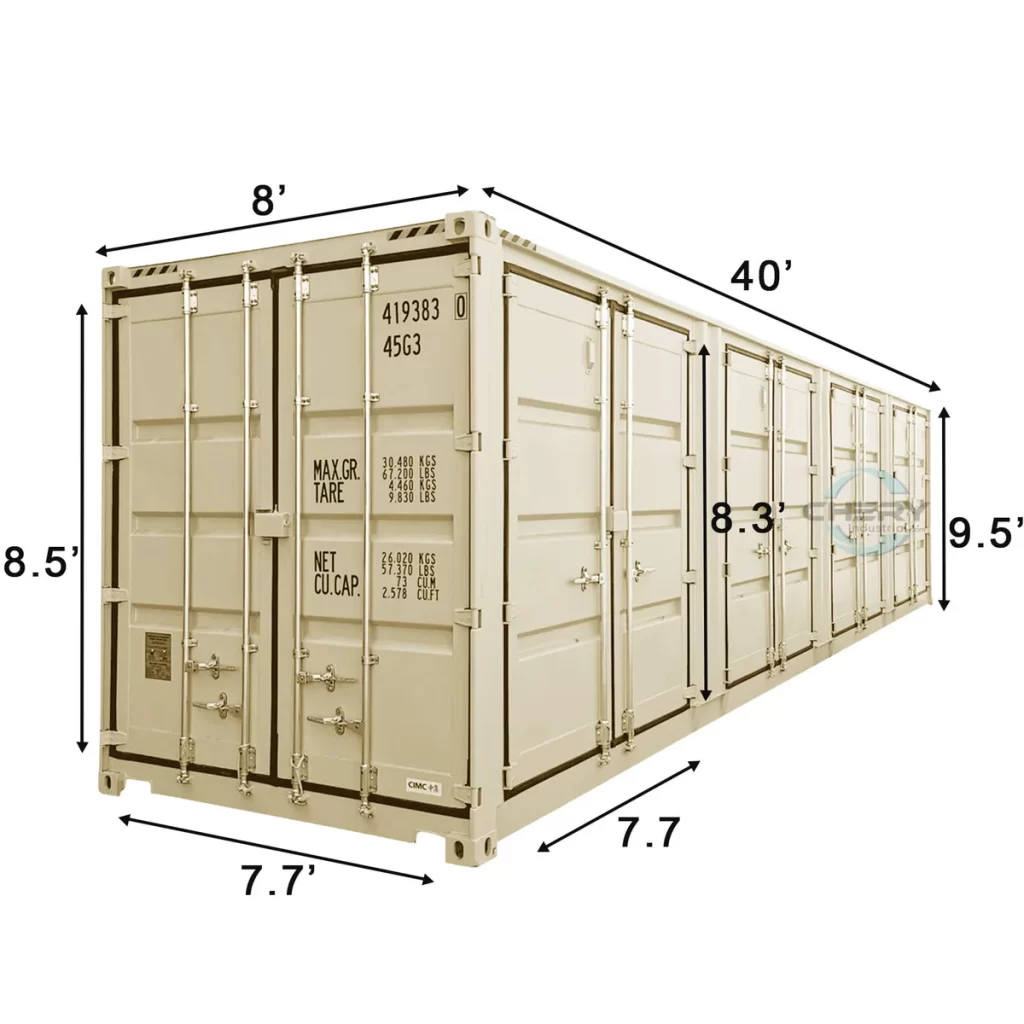- By TOP CHINA FREIGHT
- August 14, 2025
- Shipping
HQ containers (high-cube containers) offer extra height and about 10% more cargo volume than standard containers, making them ideal for tall or bulky goods. Preferred by freight forwarders and shippers, they enhance efficiency in sea, truck, and rail transport while reducing shipping costs and improving transit safety.

1.What is an HQ Container?
An hq container is a high-cube shipping container designed to offer additional vertical space compared to standard containers. While standard containers have a height of 8ft 6in, high-cube containers are 9ft 6in tall. This simple difference increases cargo volume by roughly 10%, making them ideal for:
- Tall machinery or industrial equipment
- Furniture and appliances
- Bulk e-commerce shipments
- Construction materials
High-cube containers are compatible with ocean, rail, and truck transportation, ensuring goods move efficiently across multiple modes.
2.Types of HQ Containers
There are several types of hq containers, each tailored to specific cargo needs:
| Type | Description | Ideal Use | Transportation Considerations |
|---|---|---|---|
| Standard HQ Container | 40ft length, 9ft 6in height | General cargo | Compatible with most ports and carriers |
| Refrigerated HQ Container (Reefer HQ) | Maintains temperature for sensitive goods | Pharmaceuticals, frozen food | Requires reefer-compatible trucks for inland transport |
| Open-Top HQ Container | Removable roof for tall cargo | Machinery, oversized equipment | Cranes or special handling equipment required |
| Flat-Rack HQ Container | Collapsible sides for irregular or oversized cargo | Construction materials, industrial equipment | Easy loading/unloading, suitable for rail and sea |
3.Advantages of HQ Containers
Extra space reduces risk of damage during handling.
Transporting more goods per shipment reduces per-unit shipping costs.
Extra height allows more items to be shipped per container.
Suitable for sea, rail, and truck shipments.
Can accommodate irregular-shaped cargo that would not fit in standard containers.
4.HQ Container vs Standard Container
| Feature | Standard Container | HQ Container | Benefit |
|---|---|---|---|
| Height | 8ft 6in | 9ft 6in | ~10% more volume |
| Volume | 33-67 m³ | 37-76 m³ | More goods per shipment |
| Weight Capacity | 24,000-30,480 kg | 24,000-30,480 kg | Same weight, increased volume |
| Ideal Cargo | Normal pallets | Tall or stacked cargo | Efficient for bulky shipments |
| Transportation | Sea, truck, rail | Sea, truck, rail | Slight adjustments needed for height clearance |
5.Applications of HQ Containers
HQ containers are used across industries due to their versatility:
- Furniture & Home Appliances: Tall items fit without disassembly.
- Industrial Equipment: Safely transports machinery that exceeds standard container height.
- E-commerce & Retail: Consolidates high-volume shipments efficiently.
- Construction & Building Materials: Flat-rack or open-top HQ containers carry long or oversized items.
- Food & Pharmaceuticals: Refrigerated HQ containers maintain temperature while maximizing volume.
6.Transportation Considerations for HQ Containers
| Shipping Considerations | Details / Tips |
|---|---|
| Port Restrictions | Verify crane height and container yard limits to ensure smooth handling. |
| Truck & Rail Compatibility | Make sure inland transport vehicles can accommodate the taller dimensions of HQ containers. |
| Shipping Costs | Some carriers charge extra due to the larger size; plan budgets accordingly. |
| Route Planning | Check tunnels, bridges, and overhead clearance for road transport. |
| Handling Equipment | Ensure cranes, forklifts, and container spreaders are compatible with high-cube containers. |
| Tips for Efficient Transportation | – Measure cargo height to maximize container space. – Consolidate smaller shipments into one HQ container. – Collaborate with freight forwarders experienced with HQ containers. – Use multi-modal transport strategies to save costs and time. |
7.Common Misconceptions about HQ Containers
1.“HQ containers are only for sea freight.”
Incorrect. They can be used in rail and truck transport as well.
2.“HQ containers cost significantly more than standard containers.”
While some carriers charge slightly more, the extra cargo volume often offsets the additional cost.
3.“All ports can handle HQ containers.”
Not true. Some smaller ports have height restrictions or specialized handling requirements.
8.Real-World Example of HQ Container Efficiency
A furniture exporter shipping 200 tall cabinets:
- Using standard containers: 10 containers needed.
- Using hq containers: Only 9 containers needed due to extra height.
This reduces shipping costs, handling time, and port congestion.
Conclusion
The hq container is a critical asset in modern logistics, offering extra height and volume for efficient shipping. By understanding container types, dimensions, applications, and transportation considerations, shippers and freight forwarders can optimize cargo handling, reduce costs, and ensure safer deliveries.
Need a Shipping Quote?
If you want expert guidance and peace of mind, our team is ready to assist.
TJ China Freight offers tailored solutions to help businesses of all sizes ship more reliably from China.
FAQs
Q1:What are the main uses of HQ containers?
HQ containers are ideal for transporting tall or bulky cargo such as furniture, machinery, appliances, construction materials, and high-volume e-commerce shipments.
Q2:Can HQ containers be used for refrigerated goods?
Yes, refrigerated high-cube containers (Reefer HQ) maintain temperature-sensitive cargo while providing extra vertical space.
Q3:Are there any restrictions when shipping HQ containers?
Yes, some ports, trucks, and rail systems have height restrictions. Route planning is essential to avoid clearance issues with tunnels, bridges, or overhead obstacles.
Q4:Do HQ containers cost more to ship than standard containers?
Some carriers may charge slightly higher fees due to their larger size, but the increased cargo volume often offsets the extra cost.
Q5:Can HQ containers be used in multi-modal transportation?
Absolutely. HQ containers are compatible with sea, rail, and truck transport, but it’s important to verify vehicle and equipment compatibility.
